Openness and Wage Inequality: Italy and Sweden Analysis
VerifiedAdded on 2023/01/10
|9
|1149
|81
Report
AI Summary
This report, prepared for an international organization/government, examines the relationship between openness and wage inequality in Italy and Sweden. The analysis begins with visual presentations of the correlation between openness and the GINI index for both countries, followed by an examination of the correlation between trade participation and the wage gap of skilled and unskilled labor. The report then applies the Stolper-Samuelson Theorem to explain how trade impacts factor returns and the GINI index. Furthermore, the report includes an economic model exploring production possibilities and equilibrium under free trade conditions, including opportunity costs and relative prices. The report concludes with an assessment of the gains from trade for both countries. The report utilizes data analysis and economic theory to provide expert advice on international trade conditions in Italy and Sweden.
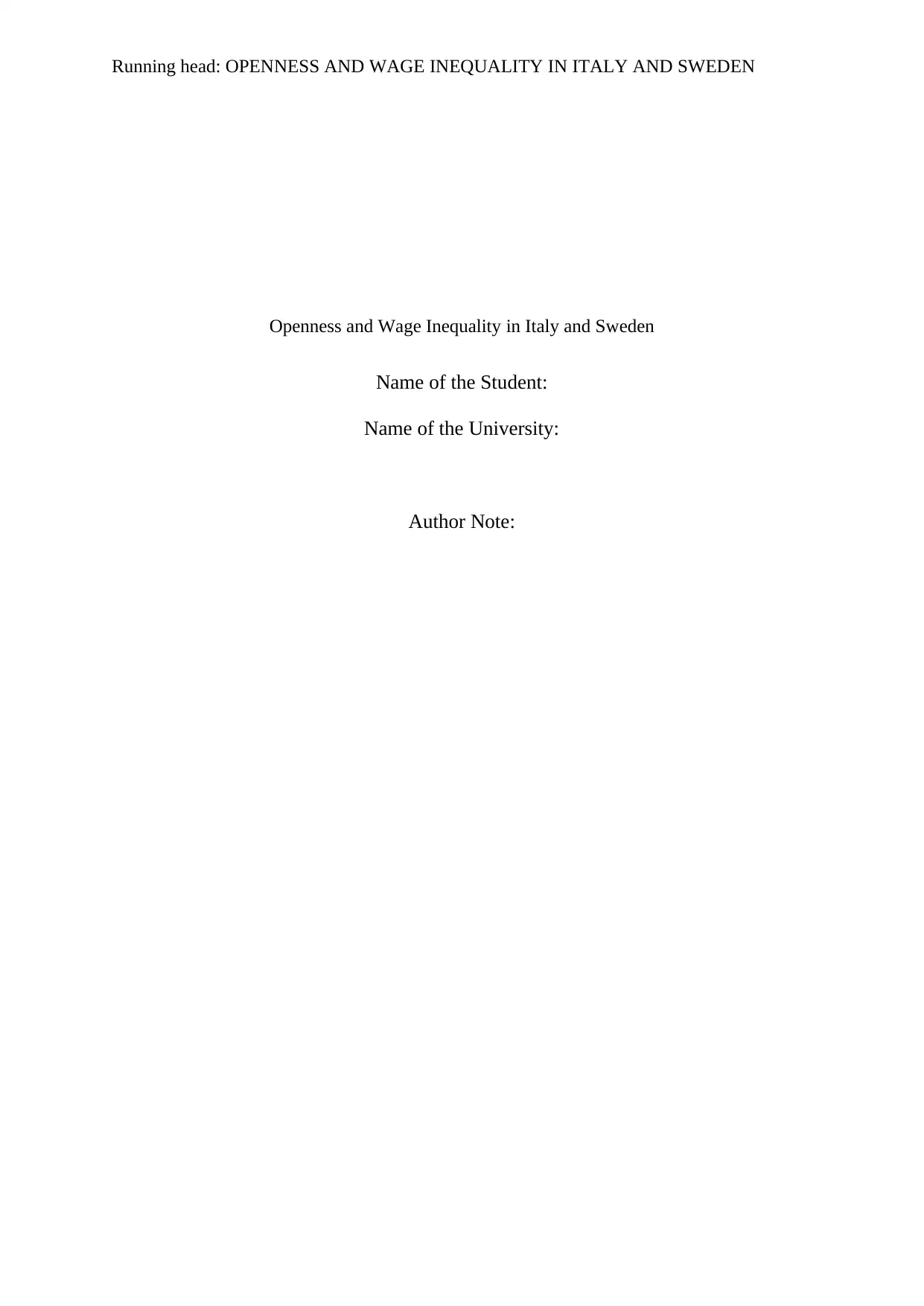
Running head: OPENNESS AND WAGE INEQUALITY IN ITALY AND SWEDEN
Openness and Wage Inequality in Italy and Sweden
Name of the Student:
Name of the University:
Author Note:
Openness and Wage Inequality in Italy and Sweden
Name of the Student:
Name of the University:
Author Note:
Paraphrase This Document
Need a fresh take? Get an instant paraphrase of this document with our AI Paraphraser
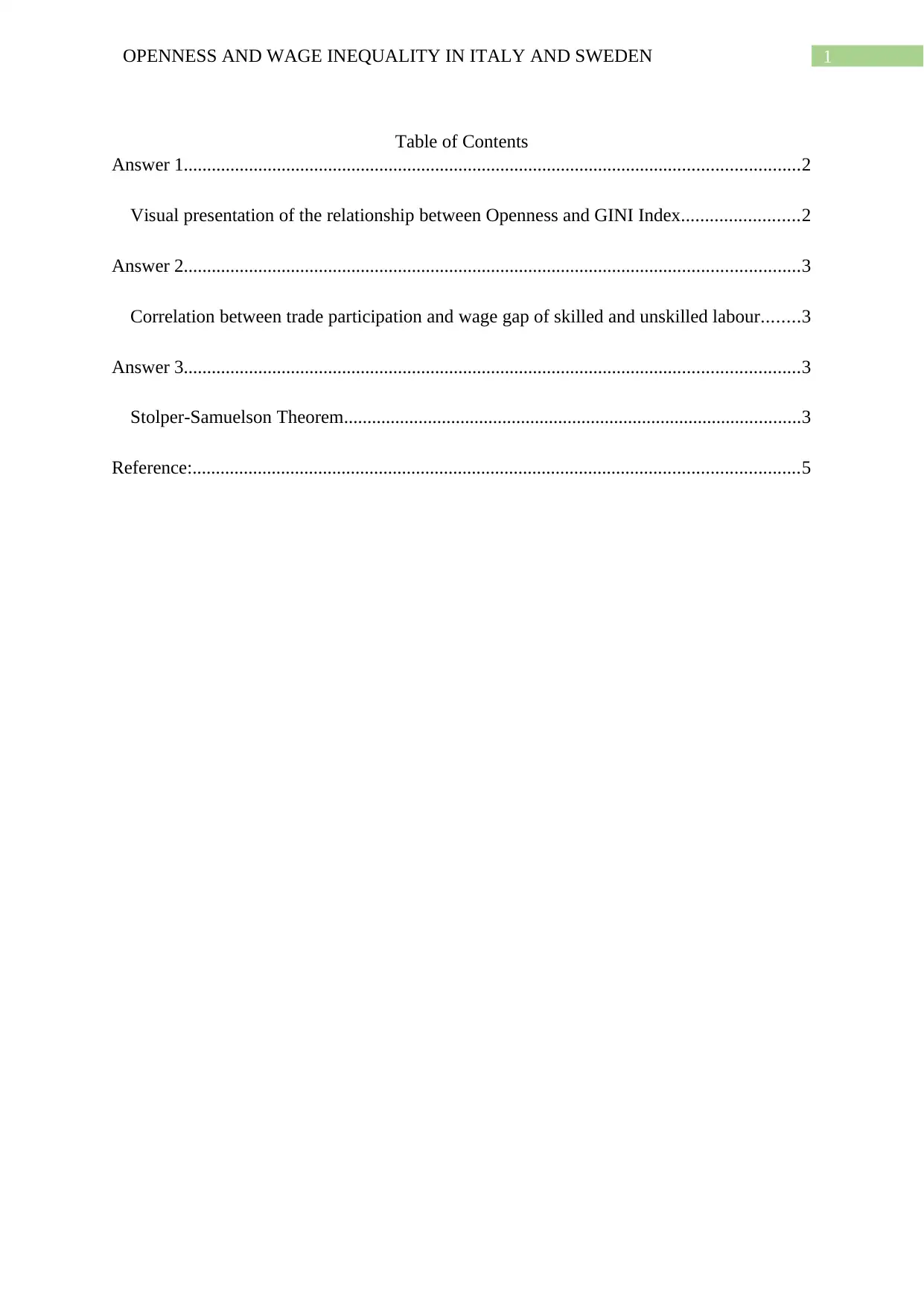
1OPENNESS AND WAGE INEQUALITY IN ITALY AND SWEDEN
Table of Contents
Answer 1....................................................................................................................................2
Visual presentation of the relationship between Openness and GINI Index.........................2
Answer 2....................................................................................................................................3
Correlation between trade participation and wage gap of skilled and unskilled labour........3
Answer 3....................................................................................................................................3
Stolper-Samuelson Theorem..................................................................................................3
Reference:..................................................................................................................................5
Table of Contents
Answer 1....................................................................................................................................2
Visual presentation of the relationship between Openness and GINI Index.........................2
Answer 2....................................................................................................................................3
Correlation between trade participation and wage gap of skilled and unskilled labour........3
Answer 3....................................................................................................................................3
Stolper-Samuelson Theorem..................................................................................................3
Reference:..................................................................................................................................5
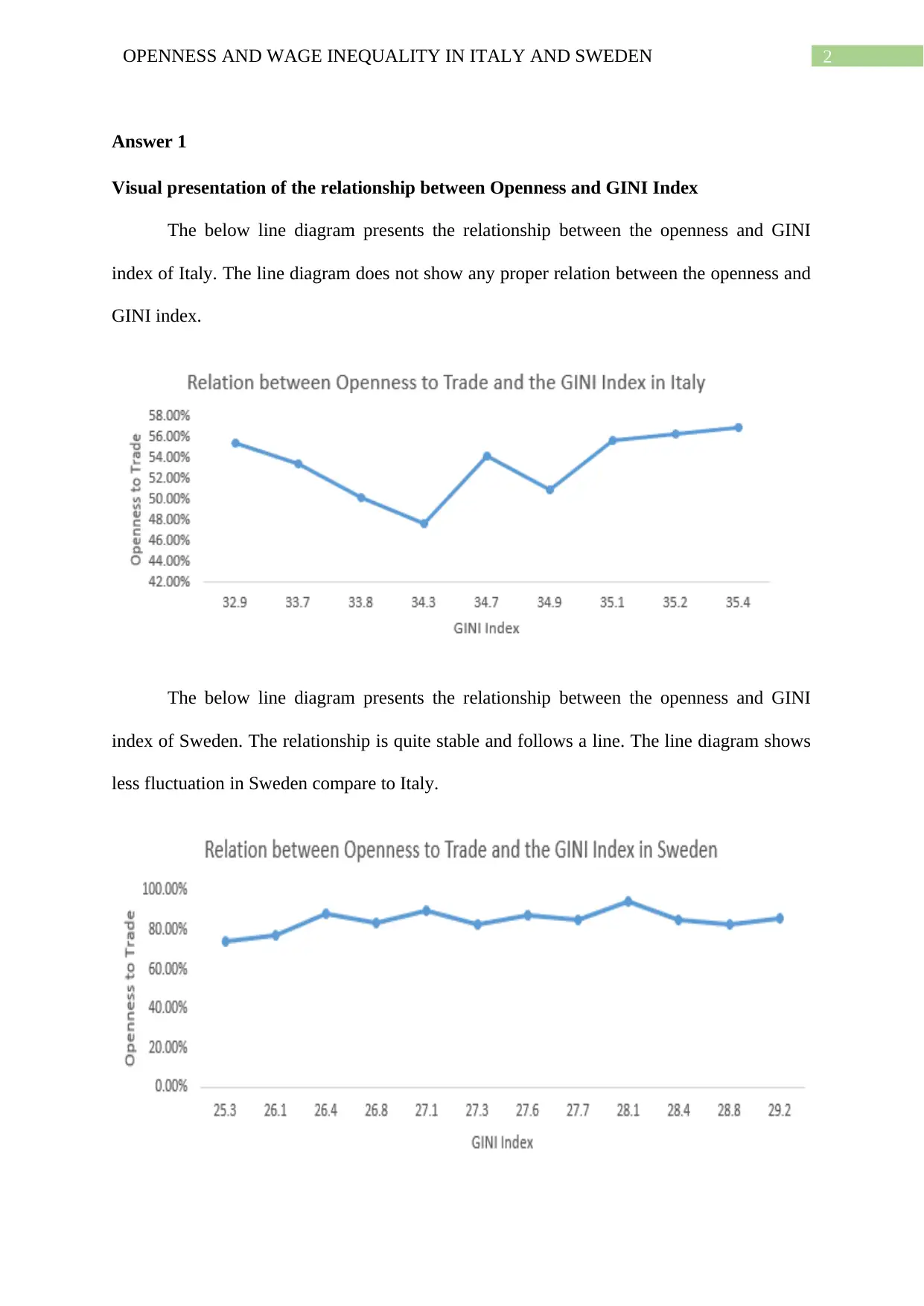
2OPENNESS AND WAGE INEQUALITY IN ITALY AND SWEDEN
Answer 1
Visual presentation of the relationship between Openness and GINI Index
The below line diagram presents the relationship between the openness and GINI
index of Italy. The line diagram does not show any proper relation between the openness and
GINI index.
The below line diagram presents the relationship between the openness and GINI
index of Sweden. The relationship is quite stable and follows a line. The line diagram shows
less fluctuation in Sweden compare to Italy.
Answer 1
Visual presentation of the relationship between Openness and GINI Index
The below line diagram presents the relationship between the openness and GINI
index of Italy. The line diagram does not show any proper relation between the openness and
GINI index.
The below line diagram presents the relationship between the openness and GINI
index of Sweden. The relationship is quite stable and follows a line. The line diagram shows
less fluctuation in Sweden compare to Italy.
⊘ This is a preview!⊘
Do you want full access?
Subscribe today to unlock all pages.

Trusted by 1+ million students worldwide
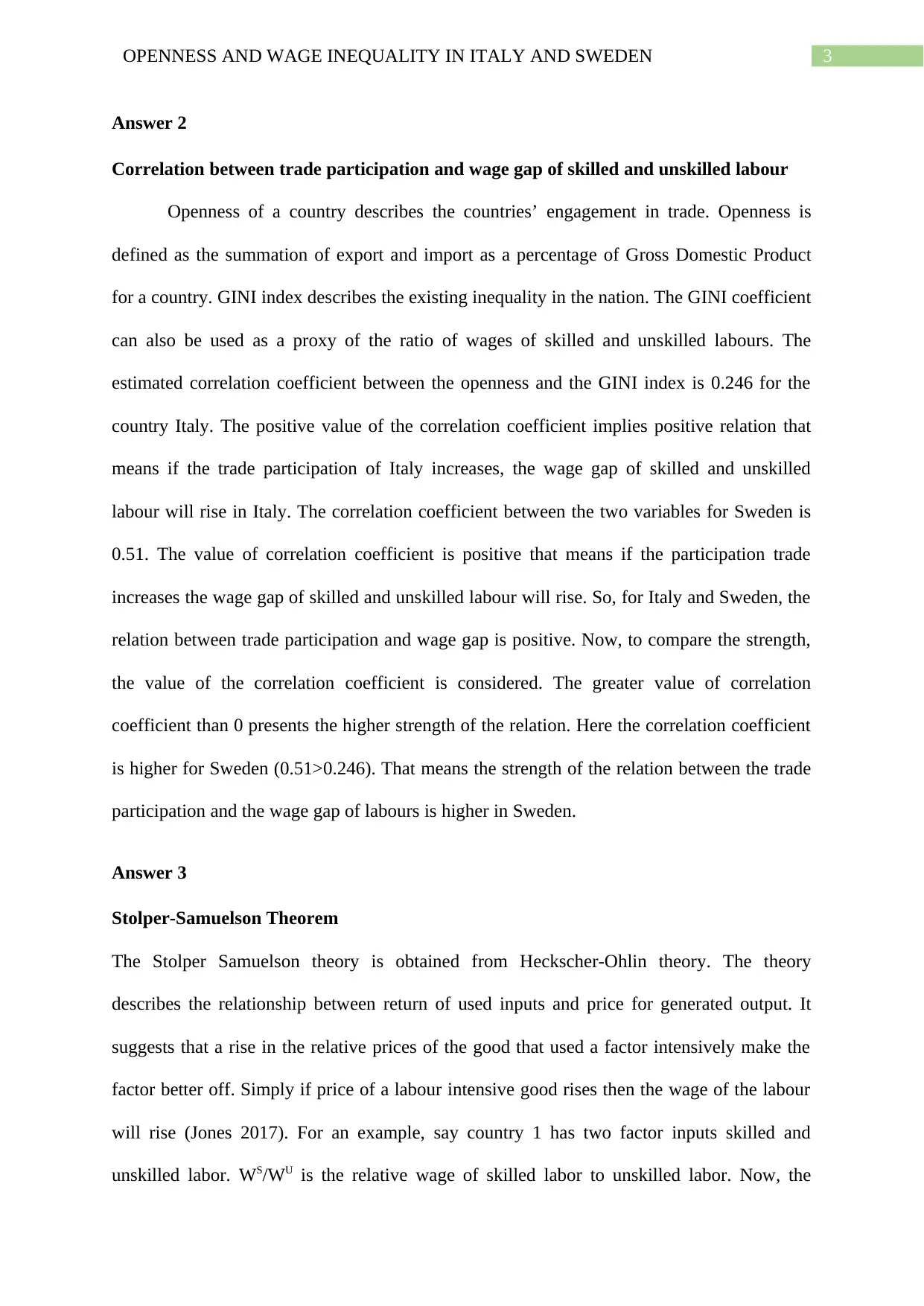
3OPENNESS AND WAGE INEQUALITY IN ITALY AND SWEDEN
Answer 2
Correlation between trade participation and wage gap of skilled and unskilled labour
Openness of a country describes the countries’ engagement in trade. Openness is
defined as the summation of export and import as a percentage of Gross Domestic Product
for a country. GINI index describes the existing inequality in the nation. The GINI coefficient
can also be used as a proxy of the ratio of wages of skilled and unskilled labours. The
estimated correlation coefficient between the openness and the GINI index is 0.246 for the
country Italy. The positive value of the correlation coefficient implies positive relation that
means if the trade participation of Italy increases, the wage gap of skilled and unskilled
labour will rise in Italy. The correlation coefficient between the two variables for Sweden is
0.51. The value of correlation coefficient is positive that means if the participation trade
increases the wage gap of skilled and unskilled labour will rise. So, for Italy and Sweden, the
relation between trade participation and wage gap is positive. Now, to compare the strength,
the value of the correlation coefficient is considered. The greater value of correlation
coefficient than 0 presents the higher strength of the relation. Here the correlation coefficient
is higher for Sweden (0.51>0.246). That means the strength of the relation between the trade
participation and the wage gap of labours is higher in Sweden.
Answer 3
Stolper-Samuelson Theorem
The Stolper Samuelson theory is obtained from Heckscher-Ohlin theory. The theory
describes the relationship between return of used inputs and price for generated output. It
suggests that a rise in the relative prices of the good that used a factor intensively make the
factor better off. Simply if price of a labour intensive good rises then the wage of the labour
will rise (Jones 2017). For an example, say country 1 has two factor inputs skilled and
unskilled labor. WS/WU is the relative wage of skilled labor to unskilled labor. Now, the
Answer 2
Correlation between trade participation and wage gap of skilled and unskilled labour
Openness of a country describes the countries’ engagement in trade. Openness is
defined as the summation of export and import as a percentage of Gross Domestic Product
for a country. GINI index describes the existing inequality in the nation. The GINI coefficient
can also be used as a proxy of the ratio of wages of skilled and unskilled labours. The
estimated correlation coefficient between the openness and the GINI index is 0.246 for the
country Italy. The positive value of the correlation coefficient implies positive relation that
means if the trade participation of Italy increases, the wage gap of skilled and unskilled
labour will rise in Italy. The correlation coefficient between the two variables for Sweden is
0.51. The value of correlation coefficient is positive that means if the participation trade
increases the wage gap of skilled and unskilled labour will rise. So, for Italy and Sweden, the
relation between trade participation and wage gap is positive. Now, to compare the strength,
the value of the correlation coefficient is considered. The greater value of correlation
coefficient than 0 presents the higher strength of the relation. Here the correlation coefficient
is higher for Sweden (0.51>0.246). That means the strength of the relation between the trade
participation and the wage gap of labours is higher in Sweden.
Answer 3
Stolper-Samuelson Theorem
The Stolper Samuelson theory is obtained from Heckscher-Ohlin theory. The theory
describes the relationship between return of used inputs and price for generated output. It
suggests that a rise in the relative prices of the good that used a factor intensively make the
factor better off. Simply if price of a labour intensive good rises then the wage of the labour
will rise (Jones 2017). For an example, say country 1 has two factor inputs skilled and
unskilled labor. WS/WU is the relative wage of skilled labor to unskilled labor. Now, the
Paraphrase This Document
Need a fresh take? Get an instant paraphrase of this document with our AI Paraphraser
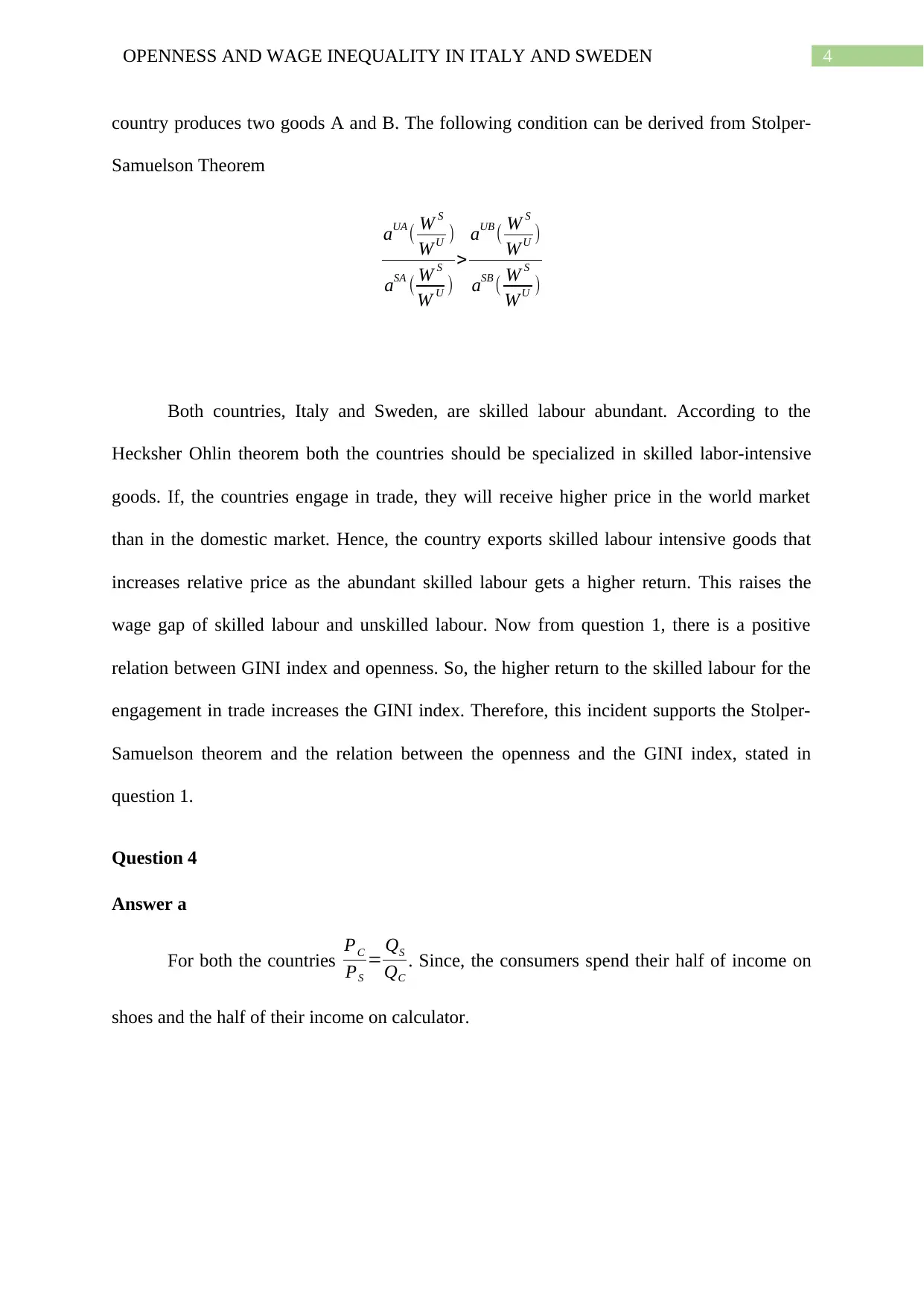
4OPENNESS AND WAGE INEQUALITY IN ITALY AND SWEDEN
country produces two goods A and B. The following condition can be derived from Stolper-
Samuelson Theorem
aUA ( W S
W U )
aSA ( W S
W U )
>
aUB ( W S
W U )
aSB ( W S
WU )
Both countries, Italy and Sweden, are skilled labour abundant. According to the
Hecksher Ohlin theorem both the countries should be specialized in skilled labor-intensive
goods. If, the countries engage in trade, they will receive higher price in the world market
than in the domestic market. Hence, the country exports skilled labour intensive goods that
increases relative price as the abundant skilled labour gets a higher return. This raises the
wage gap of skilled labour and unskilled labour. Now from question 1, there is a positive
relation between GINI index and openness. So, the higher return to the skilled labour for the
engagement in trade increases the GINI index. Therefore, this incident supports the Stolper-
Samuelson theorem and the relation between the openness and the GINI index, stated in
question 1.
Question 4
Answer a
For both the countries PC
PS
= QS
QC
. Since, the consumers spend their half of income on
shoes and the half of their income on calculator.
country produces two goods A and B. The following condition can be derived from Stolper-
Samuelson Theorem
aUA ( W S
W U )
aSA ( W S
W U )
>
aUB ( W S
W U )
aSB ( W S
WU )
Both countries, Italy and Sweden, are skilled labour abundant. According to the
Hecksher Ohlin theorem both the countries should be specialized in skilled labor-intensive
goods. If, the countries engage in trade, they will receive higher price in the world market
than in the domestic market. Hence, the country exports skilled labour intensive goods that
increases relative price as the abundant skilled labour gets a higher return. This raises the
wage gap of skilled labour and unskilled labour. Now from question 1, there is a positive
relation between GINI index and openness. So, the higher return to the skilled labour for the
engagement in trade increases the GINI index. Therefore, this incident supports the Stolper-
Samuelson theorem and the relation between the openness and the GINI index, stated in
question 1.
Question 4
Answer a
For both the countries PC
PS
= QS
QC
. Since, the consumers spend their half of income on
shoes and the half of their income on calculator.
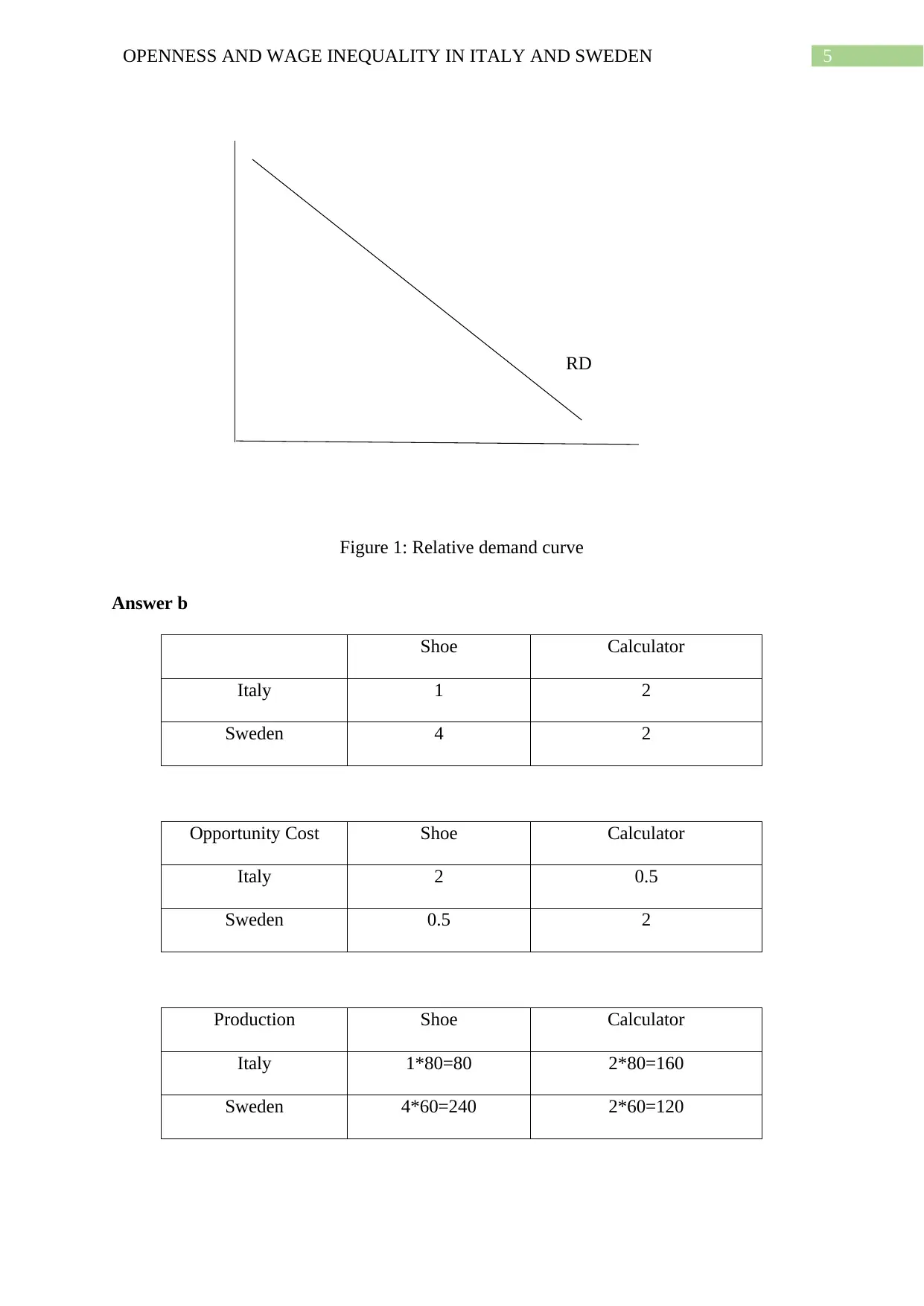
5OPENNESS AND WAGE INEQUALITY IN ITALY AND SWEDEN
RD
Figure 1: Relative demand curve
Answer b
Shoe Calculator
Italy 1 2
Sweden 4 2
Opportunity Cost Shoe Calculator
Italy 2 0.5
Sweden 0.5 2
Production Shoe Calculator
Italy 1*80=80 2*80=160
Sweden 4*60=240 2*60=120
RD
Figure 1: Relative demand curve
Answer b
Shoe Calculator
Italy 1 2
Sweden 4 2
Opportunity Cost Shoe Calculator
Italy 2 0.5
Sweden 0.5 2
Production Shoe Calculator
Italy 1*80=80 2*80=160
Sweden 4*60=240 2*60=120
⊘ This is a preview!⊘
Do you want full access?
Subscribe today to unlock all pages.

Trusted by 1+ million students worldwide
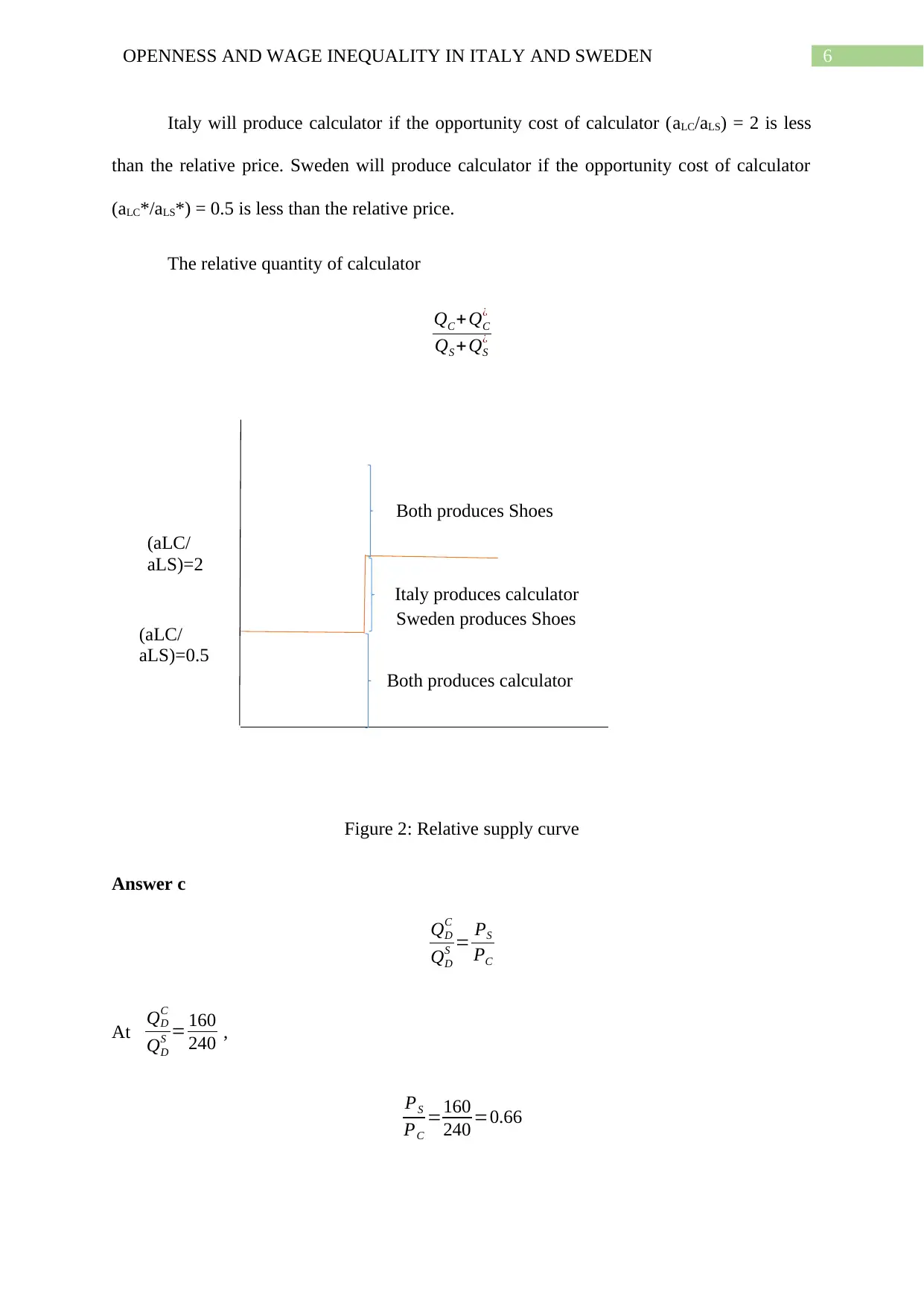
6OPENNESS AND WAGE INEQUALITY IN ITALY AND SWEDEN
(aLC/
aLS)=2
(aLC/
aLS)=0.5
Both produces calculator
Both produces Shoes
Italy produces calculator
Sweden produces Shoes
Italy will produce calculator if the opportunity cost of calculator (aLC/aLS) = 2 is less
than the relative price. Sweden will produce calculator if the opportunity cost of calculator
(aLC*/aLS*) = 0.5 is less than the relative price.
The relative quantity of calculator
QC+QC
¿
QS +QS
¿
Figure 2: Relative supply curve
Answer c
QD
C
QD
S = PS
PC
At QD
C
QD
S = 160
240 ,
PS
PC
=160
240 =0.66
(aLC/
aLS)=2
(aLC/
aLS)=0.5
Both produces calculator
Both produces Shoes
Italy produces calculator
Sweden produces Shoes
Italy will produce calculator if the opportunity cost of calculator (aLC/aLS) = 2 is less
than the relative price. Sweden will produce calculator if the opportunity cost of calculator
(aLC*/aLS*) = 0.5 is less than the relative price.
The relative quantity of calculator
QC+QC
¿
QS +QS
¿
Figure 2: Relative supply curve
Answer c
QD
C
QD
S = PS
PC
At QD
C
QD
S = 160
240 ,
PS
PC
=160
240 =0.66
Paraphrase This Document
Need a fresh take? Get an instant paraphrase of this document with our AI Paraphraser
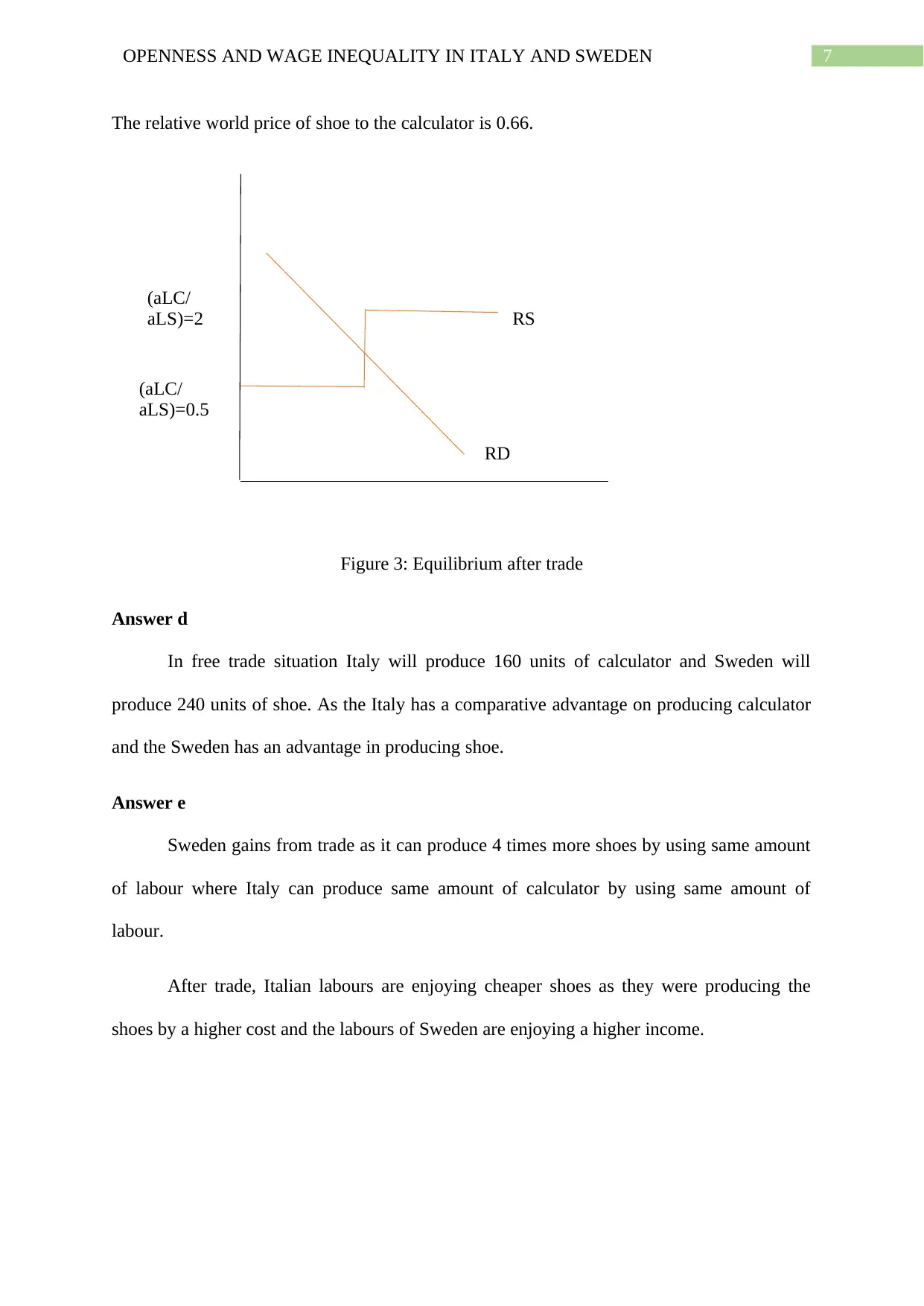
7OPENNESS AND WAGE INEQUALITY IN ITALY AND SWEDEN
(aLC/
aLS)=2
(aLC/
aLS)=0.5
RS
RD
The relative world price of shoe to the calculator is 0.66.
Figure 3: Equilibrium after trade
Answer d
In free trade situation Italy will produce 160 units of calculator and Sweden will
produce 240 units of shoe. As the Italy has a comparative advantage on producing calculator
and the Sweden has an advantage in producing shoe.
Answer e
Sweden gains from trade as it can produce 4 times more shoes by using same amount
of labour where Italy can produce same amount of calculator by using same amount of
labour.
After trade, Italian labours are enjoying cheaper shoes as they were producing the
shoes by a higher cost and the labours of Sweden are enjoying a higher income.
(aLC/
aLS)=2
(aLC/
aLS)=0.5
RS
RD
The relative world price of shoe to the calculator is 0.66.
Figure 3: Equilibrium after trade
Answer d
In free trade situation Italy will produce 160 units of calculator and Sweden will
produce 240 units of shoe. As the Italy has a comparative advantage on producing calculator
and the Sweden has an advantage in producing shoe.
Answer e
Sweden gains from trade as it can produce 4 times more shoes by using same amount
of labour where Italy can produce same amount of calculator by using same amount of
labour.
After trade, Italian labours are enjoying cheaper shoes as they were producing the
shoes by a higher cost and the labours of Sweden are enjoying a higher income.
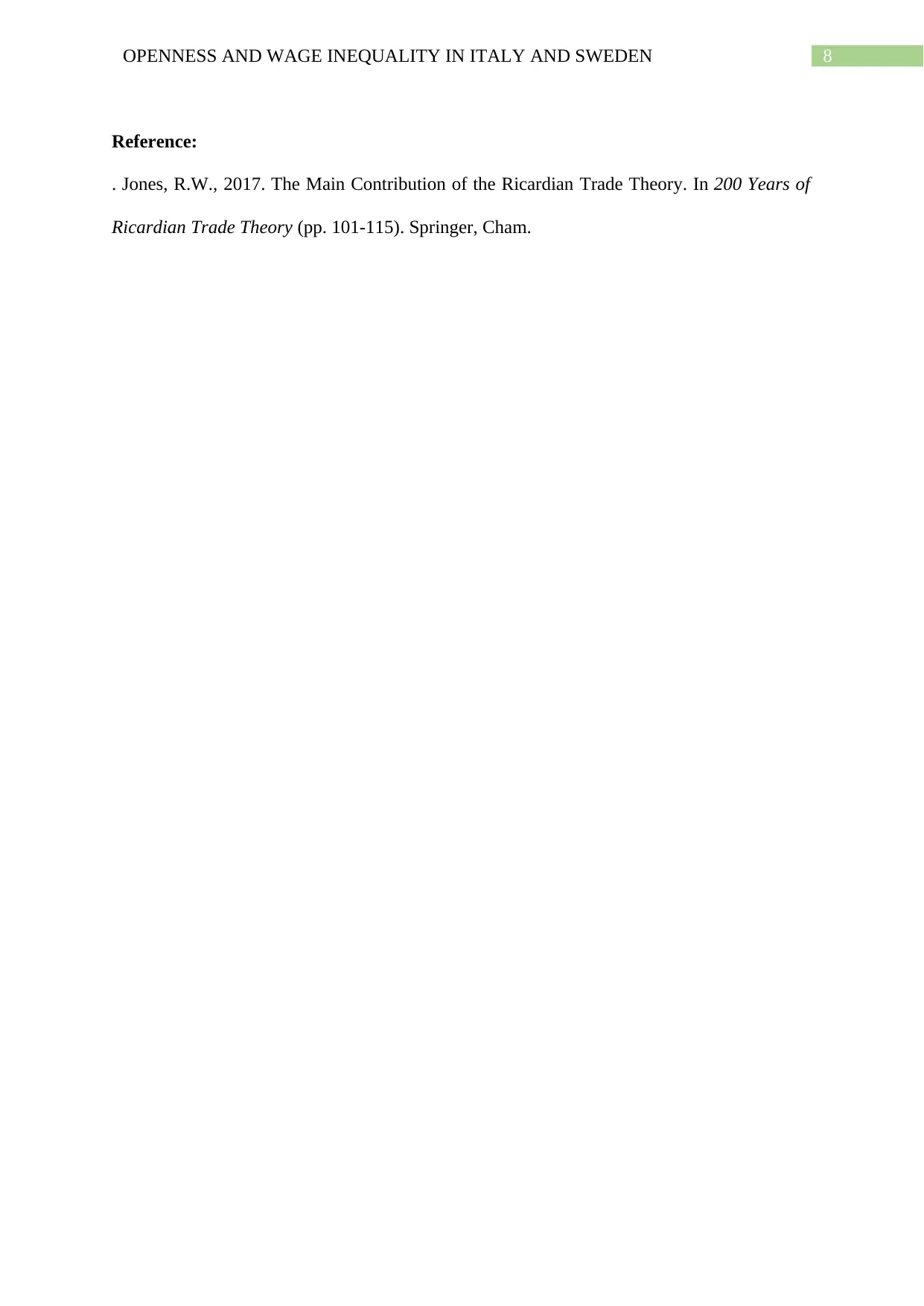
8OPENNESS AND WAGE INEQUALITY IN ITALY AND SWEDEN
Reference:
. Jones, R.W., 2017. The Main Contribution of the Ricardian Trade Theory. In 200 Years of
Ricardian Trade Theory (pp. 101-115). Springer, Cham.
Reference:
. Jones, R.W., 2017. The Main Contribution of the Ricardian Trade Theory. In 200 Years of
Ricardian Trade Theory (pp. 101-115). Springer, Cham.
⊘ This is a preview!⊘
Do you want full access?
Subscribe today to unlock all pages.

Trusted by 1+ million students worldwide
1 out of 9
Related Documents
Your All-in-One AI-Powered Toolkit for Academic Success.
+13062052269
info@desklib.com
Available 24*7 on WhatsApp / Email
![[object Object]](/_next/static/media/star-bottom.7253800d.svg)
Unlock your academic potential
Copyright © 2020–2025 A2Z Services. All Rights Reserved. Developed and managed by ZUCOL.





